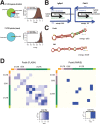Transcription factor Wilms' tumor 1 regulates developmental RNAs through 3' UTR interaction
- PMID: 28289143
- PMCID: PMC5358755
- DOI: 10.1101/gad.291500.116
Transcription factor Wilms' tumor 1 regulates developmental RNAs through 3' UTR interaction
Abstract
Wilms' tumor 1 (WT1) is essential for the development and homeostasis of multiple mesodermal tissues. Despite evidence for post-transcriptional roles, no endogenous WT1 target RNAs exist. Using RNA immunoprecipitation and UV cross-linking, we show that WT1 binds preferentially to 3' untranslated regions (UTRs) of developmental targets. These target mRNAs are down-regulated upon WT1 depletion in cell culture and developing kidney mesenchyme. Wt1 deletion leads to rapid turnover of specific mRNAs. WT1 regulates reporter gene expression through interaction with 3' UTR-binding sites. Combining experimental and computational analyses, we propose that WT1 influences key developmental and disease processes in part through regulating mRNA turnover.
Keywords: 3′ UTR; FLASH; RNA secondary structures; WT1; developmental pathways; hybrids.
© 2017 Bharathavikru et al.; Published by Cold Spring Harbor Laboratory Press.
Figures





References
-
- Astuti D, Morris MR, Cooper WN, Staals RHJ, Wake NC, Fews G, Gill H, Gentle D, Shuib S, Ricketts CJ, et al. 2012. Germline mutations in DIS3L2 cause the Perlman syndrome of overgrowth and Wilms tumor susceptibility. Nat Genet 44: 277–284. - PubMed
-
- Bailey TL, Elkan C. 1994. Fitting a mixture model by expectation maximization to discover motifs in biopolymers. Proc Int Conf Intell Syst Mol Biol 2: 28–36. - PubMed
-
- Barbaux S, Niaudet P, Gubler MC, Grünfeld JP, Jaubert F, Kuttenn F, Fékété CN, Souleyreau-Therville N, Thibaud E, Fellous M, et al. 1997. Donor splice-site mutations in WT1 are responsible for Frasier syndrome. Nat Genet 17: 467–470. - PubMed
-
- Bharathavikru R, Dudnakova T. 2016. Methods to identify and validate WT1–RNA interaction. Methods Mol Biol 1467: 197–209. - PubMed
Publication types
MeSH terms
Substances
Grants and funding
LinkOut - more resources
Full Text Sources
Other Literature Sources
Medical
Molecular Biology Databases
